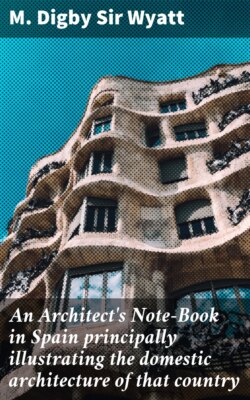Читать книгу An Architect's Note-Book in Spain principally illustrating the domestic architecture of that country - Sir M. Digby Wyatt - Страница 10
На сайте Литреса книга снята с продажи.
VALLADOLID. COLEGIO DE SAN GREGORIO.
ОглавлениеFROM early in the fifteenth century, through the reigns of Juan II. and his successors, until the elevation of Madrid into the Capital by Charles the Fifth, and into the only and official seat of the Court by Philip II. Valladolid was emphatically the Royal city of Spain. It is there, accordingly, that the traveller would naturally look for relics of Royal and courtly magnificence as displayed in the stirring times during which the over-elaboration of Gothic Art began to merge itself, in sympathy with the Medicean energies of Rome and Florence, into the style of the Renaissance as practised at a later date by many citizens of Valladolid, such as Antonio de Arphe, and Juan de Arphe y Villafañe, master-workers in gold and silver; as Juan de Juni, and Hernandez, the marvellous wood-carvers and sculptors, authors of the peculiar gilt painted groups for which the city became so famous; and as Alonzo Berruguete, Henrique de Egas, and Macias Carpintero "masters of works" of no mean repute. Of all the glorious objects these men and their disciples and contemporaries produced in Valladolid a few "disjecta membra" alone remain. Of the very building, an outlying fragment of which forms the subject of the sketch under notice, all but the actual structure was destroyed by the French under Napoleon I. in person, who in 1809 inaugurated a reign of terror in the city. "No where," in Spain, as Ford writes in 1845, "has recent destruction been more busy (than in Valladolid); witness San Benito, San Diego, San Francisco, San Gabriel, &c., almost swept away, their precious altars broken, their splendid sepulchres dashed to pieces; hence the sad void created in the treasures of art and religion which are recorded by previous travellers while now-a-days the native in this mania of modernising is fast destroying those venerable vestiges of Charles V. and Philip II. which escaped the Gaul." The situation of this city on the direct line of railway communication between France and Madrid has greatly helped forward this "modernising" and even as this is written, numerous old streets are being pulled down to make way for the convenient, but far from picturesque monotony in which the nineteenth century usually writes its date upon its street architecture. In one respect, especially, the glory of Valladolid has entirely departed. In this, the city of the Arphes, in which as Navagiero[5] says, (writing in 1525), "Sono in Valladolid assai artefeci di ogni sorte, é se vi lavora benissimo di tutte le arti, e sopra tutto d'argenti, e vi sono tanti argenteri quanti non sono in due altre terre," no gold or silversmith's work is to be found worthy a moment's attention. The "Plateria" still remains, and the shops of the Plateros still abound, but, with the exception of two or three little old fragments saved from the melting pot, the elegant types of the "Varia commensuracion" of Villafañe have disappeared, giving place to poor imitations of bad French work.
